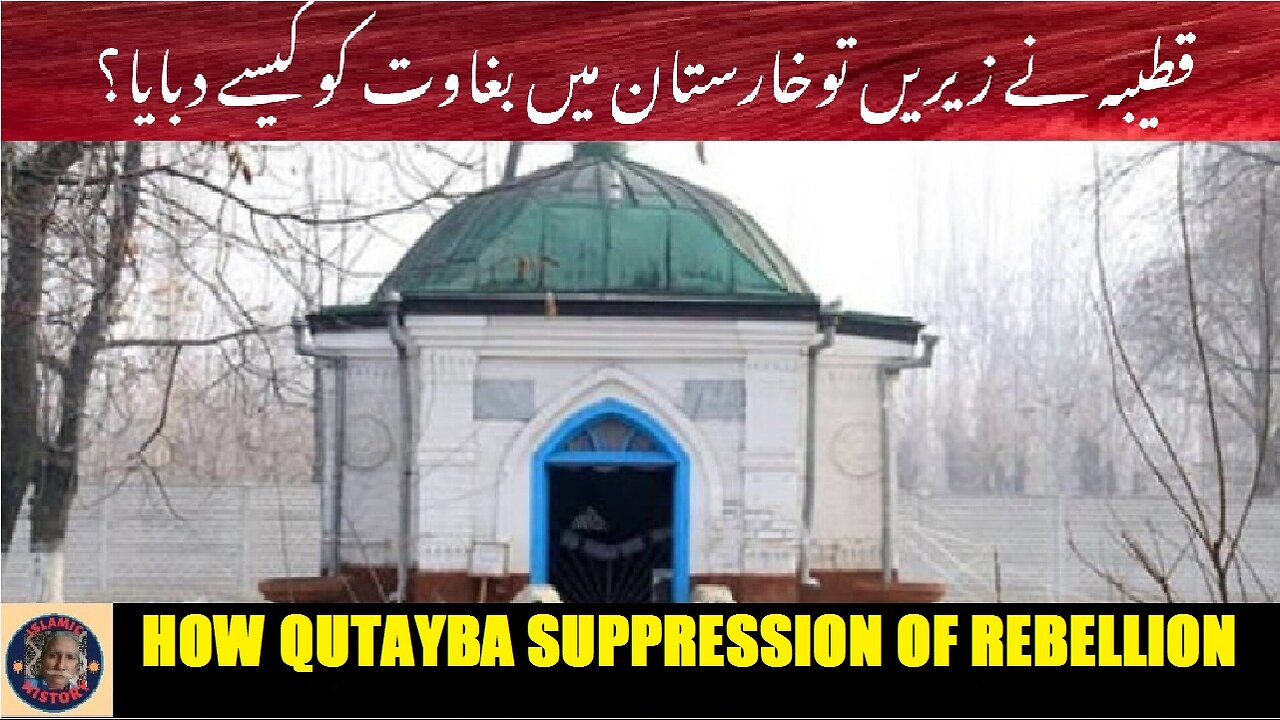Premium Only Content

How was Qutayba suppression of the rebellion. قطیبہ نے زیریں توخارستان میں بغاوت کو کیسے دبایا؟
@islamichistory813 #HistoricalAnalysis #Qutayba #Rebellion
How was Qutayba suppression of the rebellion in Lower Tokharistan.
Dekhti Aankhooon aur sountay kaanoon ko Asslamoalaikum, sisters, brothers friends and elders, In this Islamic Warrior Leaders informative videos, we are describing the events surrounding Qutayba's suppression of the rebellion in Lower Tokharistan. Through a detailed analysis, we will describe the motivations behind the rebellion, the tactics used by Qutayba, and the aftermath of this significant conflict. Watch complete video and Get to know how this episode influenced the political landscape of the region.
The Arabs had reached Central Asia in the decade after their decisive victory in the Battle of Nihavend in 642, when they completed their conquest of the former Sassanid Empire by seizing Sistan and Khurasan. The first Arab attacks across the Oxus ranged as far as Shash (Tashkent) and Khwarizm, but they were little more than raids aiming at seizing booty and extracting tribute, and were interrupted by the intertribal warfare that broke out in Khurasan during the Second Fitna (683–692). Subsequent governors, most notably Sa'id ibn Uthman and al-Muhallab ibn Abi Sufra, made attempts to conquer territory across the river, but they failed. The native princes, for their part, tried to exploit the Arabs' rivalries, and with the aid of the Arab renegade Musa ibn Abd Allah ibn Khazim, who in 689 seized the fortress of Tirmidh for his own domain, they managed to eject the Arabs from their holdings.Nevertheless, the Transoxianian princes remained riven by their own feuds, and failed to unite in the face of the Arab conquest, a fact which would be suitably exploited by Qutayba after 705. The international situation was also favourable to Qutayba. Tang China was weakened, and the Second Turkic Khaganate (682–744) was embroiled in warfare with the Türgesh Khaganate (699–766).
The first task which Qutayba set himself was the suppression of the rebellion in Lower Tokharistan. This was accomplished swiftly in spring 705, with the reconquest of Balkh. One version of events holds that the city surrendered peacefully, but another suggests it was violently captured, which seems likely as the city is mentioned as ruined a few years later.[14] Qutayba then secured the submission of the local princes in the upper Oxus valley, most notably of Tish, king of al-Saghaniyan, who invited Qutayba to aid him in his dispute with the ruler of nearby Akharun (or Akhrun) and Shuman, in the northern mountainous districts of Tokharistan. After extensive negotiations led by Sulaym the Persian, the tarkhan Nizak, ruler of the Hephthalite principality of Badghis, surrendered to Qutayba, and pledged to accompany him in his expeditions.
In 706–709, Qutayba occupied himself with the long and bloody conquest of Bukhara. Bukhara was at the time weakened by civil war: royal power had been weakened in favour of ambitious nobles during the minority of King Tughshada. The ruler of nearby Wardana, the Wardan Khudah, had seized most of Tughshada's territories, including Bukhara itself, while the remainder was ruled by another local magnate, Khunuk Khudah, who had usurped the title of king of Bukhara (Bukhar Khudah). Taking advantage of the conflict, Qutayba was able to easily capture the city of Baykand [uz] after a two-month siege. He left a small garrison there and departed, but the inhabitants launched a revolt soon after. The Arab army then turned back and proceeded to sack the city. The men of fighting age were executed, the women and children sold off as slaves, and enormous booty amassed, especially in armour and weapons, which equipped the Arab army.The high quality of the Sogdian craftmanship became proverbial as the "forging of Sughd" in Arabic accounts.
The brutal punishment meted out to Baykand shocked the region: the Sogdians patched up their quarrels and the Sogdian princes of Kish and Nasaf united behind the Wardan Khudah. Bahili accounts extolling Qutayba's achievements mention the participation of 200,000 Türgesh troops as well, but this is evidently an exaggerated anachronism. In the campaign of 707, Qutayba was able to capture two outlying towns, Tumuskath and Ramithana, before he was threatened in his rear by the united Sogdian army. Qutayba avoided a battle, and engaged in negotiations to gain time, before executing a rapid retreat to safety through the Iron Gate to beyond the Oxus, crossing the river at Tirmidh. The campaign of 708 was also a failure against the united Sogdian forces, which drew the ire of al-Hajjaj. For 709, al-Hajjaj drew up a new plan for his subordinate: the Arabs launched a direct attack on Bukhara, which caught the Sogdian alliance—possibly weakened by the death of its leader, the Wardan Khudah—by surprise. The city was taken by storm, a tribute of 200,000 dirhams imposed, and an Arab garrison installed. In its direct aftermath, Tarkhun, the ruler of Samarkand, sent envoys to Qutayba and became a tributary vassal to the Caliphate.
So sisters brothers friends and elders, tomorow we are going to described How was become Consolidation of Arab rule over Tokharistan?. Allah hafiz
============================
-
 8:27
8:27
Rethinking the Dollar
16 hours agoHow to Navigate the Crypto Boom vs. Metals Drop in 2024
6.45K3 -
 1:00:23
1:00:23
PMG
14 hours ago $2.07 earned"The Dark Alliance of Big Pharma & Big Food w/ Dr. Tenpenny"
5.98K1 -
 0:44
0:44
OfficialJadenWilliams
11 hours agoiPhone password
3.85K5 -
 13:16
13:16
Degenerate Jay
12 hours ago $2.09 earnedHow Stellar Blade Did Outfits Right
10.7K4 -
 1:01:55
1:01:55
Bright Insight
9 days agoAncient Apocalypse Review LIVESTREAM
97.3K81 -
 1:03:31
1:03:31
Steve-O's Wild Ride! Podcast
4 days ago $16.95 earnedDave Mustaine Takes Sh*t From Nobody - Wild Ride #242
44.1K20 -
 LIVE
LIVE
MissesMaam
7 hours agoRumblers Survive Cannibals and Mutants | Sons of the Forest 💚✨
1,350 watching -
 3:02:59
3:02:59
PudgeTV
11 hours ago🔵 Mod Mondays Ep 46 | Cancel This Podcast
26.8K -
 1:57:39
1:57:39
Glenn Greenwald
11 hours agoDems & Media Still Blaming Everyone But Themselves, Especially Voters; Trump Bans Pompeo & Haley, Appoints Stefanik: What Does This Reveal About Next Admin? | SYSTEM UPDATE #364
193K150 -
 30:27
30:27
Stephen Gardner
9 hours ago🔥No FREAKING way! Trump makes BEST Decision of Presidency!
128K376